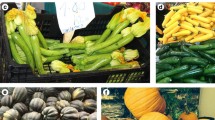Abstract
The centre of origin of coconut extends from Southwest Asia to Melanesia. Nevertheless, its pre-Columbian existence on the Pacific coast of America is attested. This raises questions about how, when and from where coconut reached America. Our molecular marker study relates the pre-Columbian coconuts to coconuts from the Philippines rather than to those of any other Pacific region, especially Polynesia. Such an origin rules out the possibility of natural dissemination by the sea currents. Our findings corroborate the interpretation of a complex of artefacts found in the Bahía de Caraquez (Ecuador) as related to South-East Asian cultures. Coconut thus appears to have been brought by Austronesian seafarers from the Philippines to Ecuador about 2,250 years BP. We discuss the implications of molecular evidence for assessing the possible contribution of early trans-pacific travels to and from America to the dissemination of domesticated plants and animals.


Similar content being viewed by others
References
Baudouin L, Lebrun P (2002) The development of a microsatellite kit and dedicated software for use with coconuts. IPGRI Report, Rome, p 52
Baudouin L, Piry S, Cornuet JM (2004) Analytical Bayesian approach for assigning individuals to populations. J Hered 95:217–224
Baudouin L, Lebrun P, Berger A, Myrie W, Been B et al (2008) The Panama Tall and the Maypan hybrid coconut in Jamaica: did genetic contamination cause a loss of resistance to Lethal Yellowing? Euphytica. doi:10.1007/s10681-007-9568-2
Been BO (1981) Observations on field resistance to lethal yellowing in coconut varieties and hybrids in Jamaica. Oleagineux 36:9–12
Borell B (2007) DNA reveals how the chicken crossed the sea. Nature 447:620–621
Broschat TK, Harrison NA, Donselman H (2002) Losses to lethal yellowing cast doubt on coconut cultivar resistance. Palms 46:185–189
Cook OF (1910) History of the coconut palm in America. Contrib US Natl Herbarium 14:271–342
De Bisschop E (1963) Vers Nousantara. La Table Ronde, Paris
Di Piazza A (1998) Archaeobotanical investigations of an earth oven in Kiribati, Gilbert Islands. Veg Hist Archaeobot 7:149–154
Estrada E, Meggers BJ (1961) A complex of traits of probable transpacific origin on the coast of Ecuador. Am Anthropol 63:913–939
Falush D, Stephens M, Pritchard JK (2003) Inference of population structure using multilocus genotype data: linked loci and correlated allele frequencies. Genetics 164:1567–1587
Harries HC (1978) The evolution, dissemination and classification of Cocos nucifera L. Bot Rev 44:266–319
Harries HC (1995) Coconut. Cocos nucifera L. (Palmae). In: Smartt J, Simmonds NW (eds) Evolution of crop plants. Longman Scientific & Technical, New York, pp 389–395
Hather J, Kirch PV (1991) Prehistoric sweet potato (Ipomea batates) from Mangaia Island, Central Polynesia. Antiquity 65:887–893
Kirch P (1989) Second millennium B·C. arboriculture in Melanesia: archaeological evidence from the Mussau Islands. Econ Bot 43:225–240
Langdon R (1993) The banana as a key to early American and Polynesian history. J Pac Hist 28:15–35
Langdon R (2001) The bamboo rafts as a key to the introduction of the sweet potato in prehistoric Polynesia. J Pac Hist 36:51–76
Lebrun P, N’cho YP, Seguin M, Grivet L, Baudouin L (1998) Genetic diversity in coconut (Cocos nucifera L.) revealed by restriction fragment length polymorphism (RFLP) markers. Euphytica 101:103–108
Lebrun P, Berger SA, Hodgkin T, Baudouin L (2005) Biochemical and molecular methods for characterizing coconut diversity. In: Batugal PA, Ramanatha Rao V, Oliver J (eds) Coconut genetic resources. International Plant Genetic Resources institute-Regional office for Asia the Pacific and Oceania (IPGRI-APO), Serdang, pp 225–251
Maloney BK (1993) Palaeoecology and the origin of the coconut. GeoJournal 31:355–362
Morcote-Ríos G, Bernal R (2001) Remains of palms (Palmae) at archaeological sites in the New World: a review. Bot Rev 67:309–350
Patiño VM (1963) Plantas cultivadas y animales domésticos en América equinoccial Tomo. I: frutales. Imprenta Departamental, Cali
Piry S, Alapetite A, Cornuet JM, Paetkau D, Baudouin L et al (2004) GENECLASS2: a software for genetic assignment and first-generation migrant detection. J Hered 95:536–539
Storey AA, Ramírez JM, Quiroz D, Burley DV, Addison DJ et al (2007) Radiocarbon and DNA evidence for a pre-Columbian introduction of Polynesian chickens to Chile. Proc Natl Acad Sci USA 104:10335–10339
Vargas A, Blanco FA (2000) Fruit characterization of Cocos nucifera L (ARECACEAE) cultivars from the Pacific coast of Costa Rica and the Philippines. Genet Resour Crop Evol 47:483–487
Ward RG, Brookfield M (1992) The dispersal of the coconut: did it float or was it carried to Panama? J Biogeogr 19:467–480
Zizumbo Villarreal D (1996) History of coconut (Cocos nucifera L.) in Mexico: 1539–1810. Genet Resour Crop Evol 43:505–515
Zizumbo Villarreal D, Quero HJ (1998) Re-evaluation of early observations on coconut in the new world 1, 2. Econ Bot 52:68–77
Acknowledgements
We thank the Cogent network, which facilitated to us obtaining the plant material and the Genotyping Platform of the Languedoc Roussillon Genopole, hosted by CIRAD (C. Billot and R. Rivallan) where all the SSR data have been obtained.
Author information
Authors and Affiliations
Corresponding author
Rights and permissions
About this article
Cite this article
Baudouin, L., Lebrun, P. Coconut (Cocos nucifera L.) DNA studies support the hypothesis of an ancient Austronesian migration from Southeast Asia to America. Genet Resour Crop Evol 56, 257–262 (2009). https://doi.org/10.1007/s10722-008-9362-6
Received:
Accepted:
Published:
Issue Date:
DOI: https://doi.org/10.1007/s10722-008-9362-6





